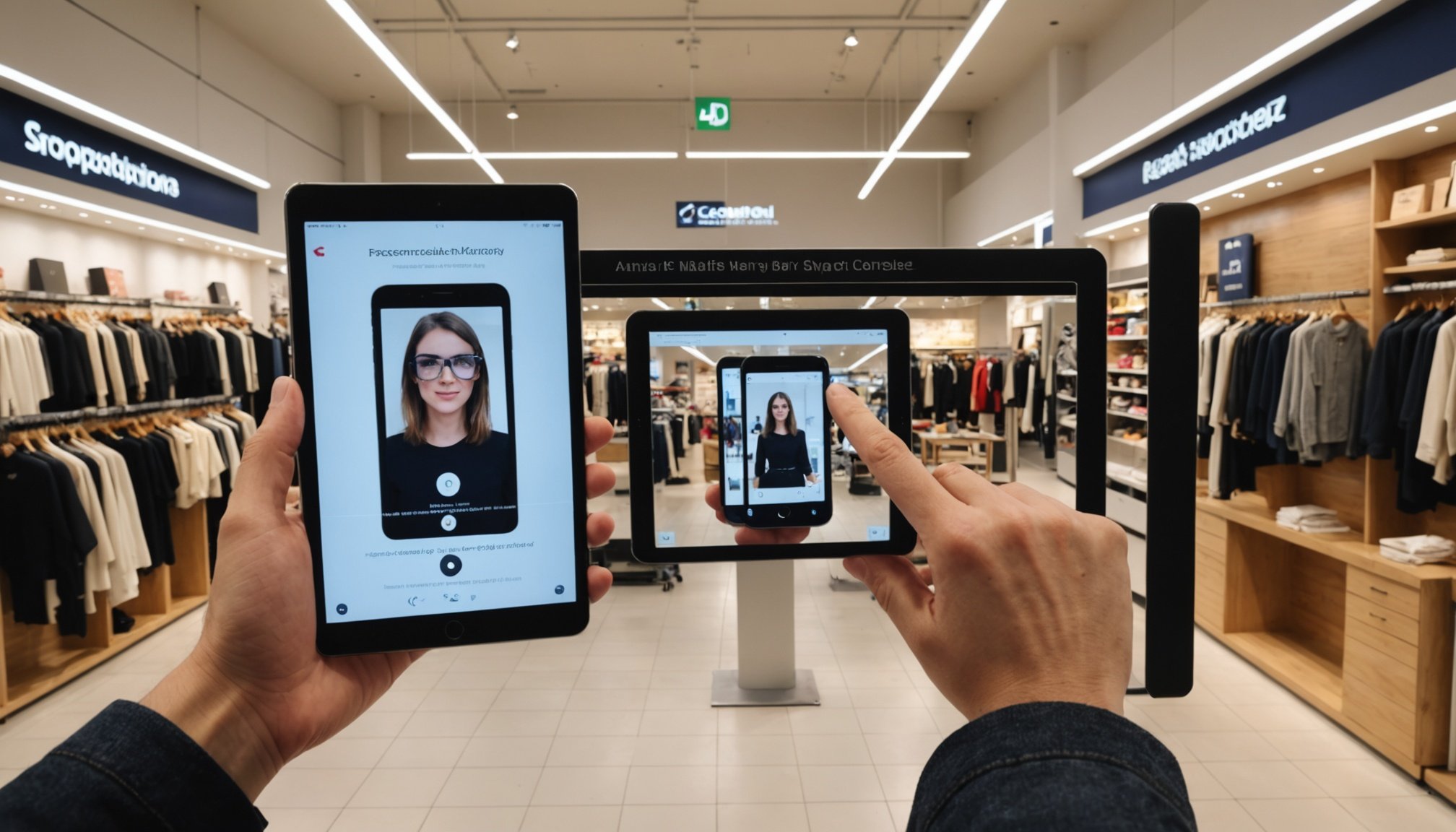Overview of Augmented Reality in Retail
Augmented reality retail is transforming how consumers interact with products by blending digital information with the physical world, making shopping experiences more immersive and interactive. This technology allows customers to visualise items like clothing and furniture within their own environments before purchasing, thus bridging the gap between online and in-store shopping.
AR shopping is gaining traction among UK retailers. From virtual fitting rooms to the simulation of real-world scenarios in retail spaces, stores are embracing AR to enhance customer engagement. As retailers compete in a crowded market, augmented reality offers a differentiating factor. Retailers such as Zara and John Lewis have started integrating AR features to capture the tech-savvy audience’s attention—a demographic that expects convenience and personalised experiences.
Also to discover : Key Insights for UK Construction Firms Embracing Smart Building Innovations
The importance of AR in retail lies in its ability to elevate the shopping experience, driving both customer satisfaction and sales. By creating novel interactions, retailers can foster stronger connections with their customers. AR can turn mundane shopping into an engaging experience, encouraging consumers to linger longer and explore more deeply, potentially leading to increased purchase rates and brand loyalty. In this competitive landscape, retailers who invest in AR stand to gain significant advantages.
Case Studies of Successful AR Implementations
Exploring AR case studies offers invaluable insights into how retail AR examples have achieved success. In the UK, innovative implementations provide compelling success stories for other retailers to emulate.
In the same genre : Elevating Cybersecurity Consciousness: Premier Training Programs for UK Enterprises
Case Study: UK Fashion Retailer
A well-known UK fashion retailer launched an AR application that enables customers to perform virtual try-ons. This tool allows shoppers to see how clothes fit and look on a digital image of themselves. The fashion retailer reported increased engagement and a 20% rise in conversion rates following the application’s release. Customers frequently praised the convenience and as an engaging feature.
Case Study: Home Goods Store
A prominent home goods store utilised AR to offer 3D product visualisation, allowing customers to place digital furniture into their own living spaces virtually. This innovation not only drove a 30% increase in online purchases but also reduced the return rate by 15%. Shoppers enjoyed the ability to confirm fit and style before buying.
Case Study: Electronics Retailer
An electronics retailer embarked on an AR initiative featuring interactive in-store displays that enhanced product demonstrations. By allowing customers to explore product features interactively, the store saw improved sales metrics and noted heightened customer satisfaction, indicating the efficacy of AR in elevating the retail experience.
Practical Applications of AR in Retail
Augmented reality (AR) has broadened the possibilities for immersive shopping experiences, offering several practical applications tailored for a tech-savvy audience. One notable application is virtual try-ons for fashion and beauty products. By allowing customers to superimpose clothing, accessories, or cosmetics onto digital self-representations, AR provides a solution to the common issue of fit and style mismatch. This not only enhances the shopping process but also reduces return rates.
Another significant application is 3D product visualization in the realm of furniture and home décor. Customers can virtually place life-sized digital models of furniture within their own living spaces. Such visualisations assist in making informed decisions by enabling buyers to assess how these items harmonize with existing furnishings.
Furthermore, interactive store displays represent an innovative leap in retail engagement. Utilising digital signage, these displays offer a dynamic way to learn about product features and options. Through interactive touch screens and augmented content, customers enjoy an enriched shopping exploration that holds their interest.
These AR applications distinctly elevate the retail environment, empowering customers to explore and interact with products in innovative ways that combine convenience with decision-making confidence.
Benefits of Augmented Reality for Customer Engagement
Augmented reality (AR) plays a crucial role in boosting customer engagement within the retail sector. This technology allows for enhanced personalization of the shopping experience, creating a more meaningful connection between the consumer and the brand. Through AR, businesses can offer immersive experiences tailored to individual preferences, which can lead to increased customer satisfaction and loyalty.
Moreover, AR significantly impacts sales and conversion rates. By enabling customers to interact with products in a virtual space, retailers provide a memorable shopping adventure that encourages purchases. The ability for shoppers to visualize how items fit into their lives before buying aids in decision-making, resulting in higher conversion rates and fewer returns.
Customer satisfaction is further elevated as AR transforms shopping into an interactive and enjoyable experience. This technology fosters deeper engagements, making customers more likely to revisit and recommend the store to others, thus driving loyalty. Such customer-centric features can differentiate a brand in a competitive market, leading to sustainable growth.
In essence, AR serves as a powerful tool in the retail industry by not only enhancing the customer journey but also delivering measurable business outcomes.
Challenges and Solutions in Adopting AR
Adopting augmented reality in the retail sector presents both opportunities and challenges. One significant hurdle is the technical difficulty of seamlessly integrating AR technology. Retailers must invest in robust IT infrastructure and staff training for effective AR deployment. AR challenges often revolve around compatibility with existing systems and maintaining up-to-date content.
Cost poses another substantial barrier, particularly for small and medium-sized retailers. The initial investment in AR can be high, covering technology acquisition, development, and ongoing maintenance. However, scalable solutions are emerging, making AR more accessible.
Retailers can overcome these implementation hurdles by adopting a phased approach. Starting with basic AR applications and gradually scaling up can minimise costs while allowing time to address technical concerns. Leveraging partnerships with tech firms can also provide valuable support and reduce financial burden.
To navigate these implementation hurdles, a clear strategy focusing on targeted outcomes is crucial. Retailers should clearly define objectives and assess the potential return on investment. By doing so, they can develop effective solutions for retailers to capitalise on AR, ensuring successful adoption and maximising the benefits of this innovative technology.
Future Trends in Augmented Reality Shopping
As the future of AR unfolds, its role in reshaping retail innovation becomes increasingly prominent. With technological advancements, emerging AR trends are set to redefine consumer engagement and shopping experiences globally. One notable prediction is the integration of AI, which is expected to vastly enhance AR’s capabilities. AI-driven personalisation will allow for even more tailored shopping experiences, adjusting suggestions in real-time based on individual preferences.
Retailers may also leverage AR to create entirely new virtual shopping environments, where consumers can explore digital malls from the comfort of home. Furthermore, the development of more sophisticated wearable AR devices is anticipated, making it even simpler for users to interact with digital content in real-world settings.
Additionally, consumer behaviour is likely to shift further towards AR shopping, driven by the demand for convenience and personalised experiences. These trends suggest a retail landscape where digital and physical shopping are more seamlessly intertwined than ever before. The adoption of blockchain for secure AR shopping transactions may also emerge as a significant trend, helping reassure consumers about the safety of their digital interactions. Overall, the future of AR promises a rich tapestry of possibilities that will continue to captivate both retailers and shoppers.











